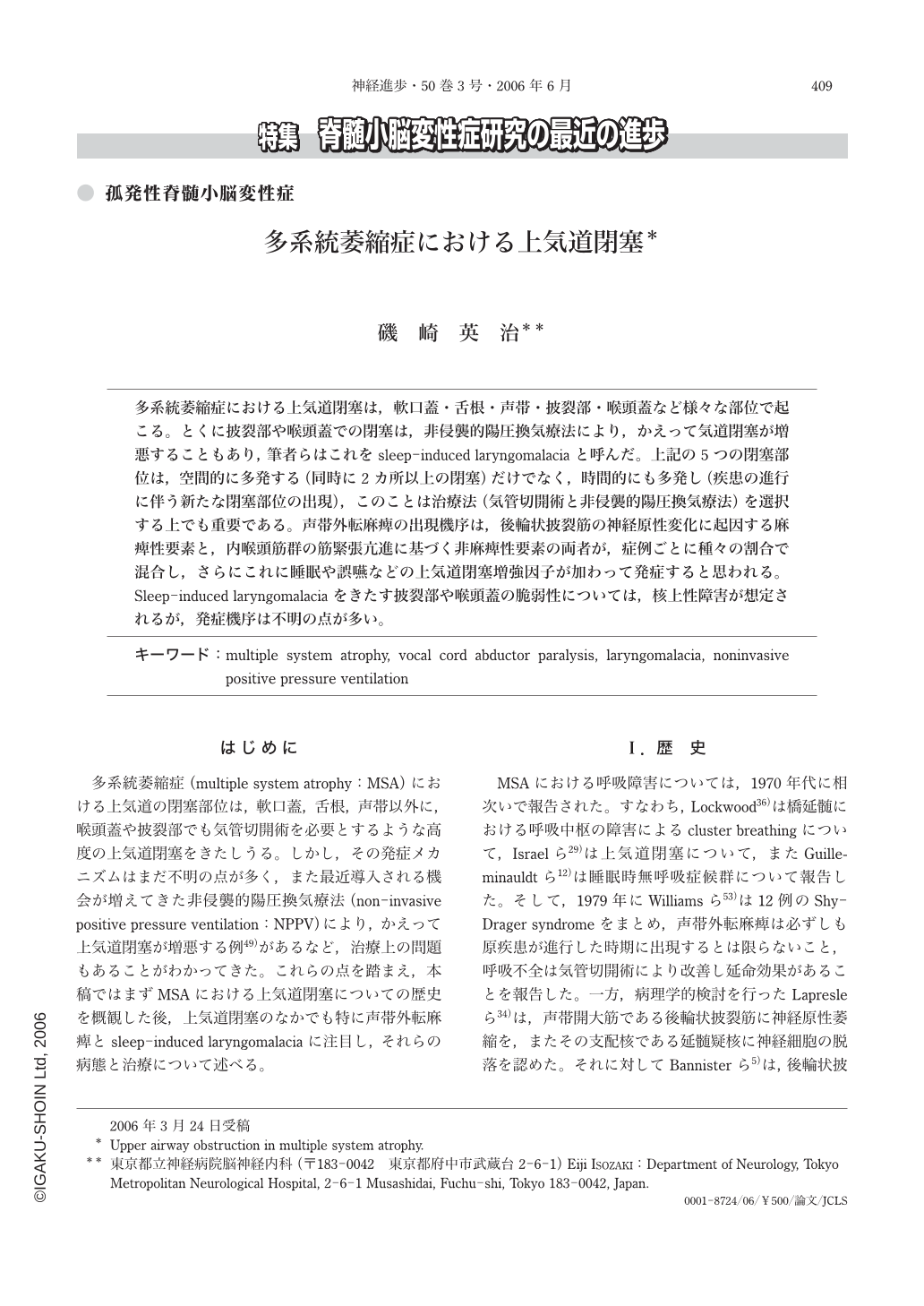Japanese
English
- 有料閲覧
- Abstract 文献概要
- 1ページ目 Look Inside
- 参考文献 Reference
多系統萎縮症における上気道閉塞は,軟口蓋・舌根・声帯・披裂部・喉頭蓋など様々な部位で起こる。とくに披裂部や喉頭蓋での閉塞は,非侵襲的陽圧換気療法により,かえって気道閉塞が増悪することもあり,筆者らはこれをsleep-induced laryngomalaciaと呼んだ。上記の5つの閉塞部位は,空間的に多発する(同時に2カ所以上の閉塞)だけでなく,時間的にも多発し(疾患の進行に伴う新たな閉塞部位の出現),このことは治療法(気管切開術と非侵襲的陽圧換気療法)を選択する上でも重要である。声帯外転麻痺の出現機序は,後輪状披裂筋の神経原性変化に起因する麻痺性要素と,内喉頭筋群の筋緊張亢進に基づく非麻痺性要素の両者が,症例ごとに種々の割合で混合し,さらにこれに睡眠や誤嚥などの上気道閉塞増強因子が加わって発症すると思われる。Sleep-induced laryngomalaciaをきたす披裂部や喉頭蓋の脆弱性については,核上性障害が想定されるが,発症機序は不明の点が多い。
In the patients with multiple system atrophy(MSA), upper airway obstruction can occur at various sites including the soft palate, the tongue base, the vocal cords, the arytenoid region, and the epiglottis. The latter two have recently been watched as another severe obstructive sites requiring a tracheostomy. While they are called as floppy arytenoid or floppy epiglottis in various diseases other than MSA, we named them as sleep-induced laryngomalacia because of the similarity to the laryngofiberscopic findings of laryngomalacia seen in infants where the supraglottic tissues including the arytenoids region and the epiglottis are pulled down into the laryngeal inlet during inspiration. Its clinical importance is that the noninvasive positive pressure ventilation(NPPV)can exacerbate airway obstruction more severely. Similar reports have been made in the past and some author even described that continuous positive airway pressure is contraindication in the patients with sleep apnea syndrome associated with lax epiglottis.
There are two multiplicities in understanding the dynamic property of the upper airway in MSA:One is the multiplicity in space, showing that the obstruction can occur simultaneously at two or more sites, and the other is the multiplicity in time, showing that another obstructive sites can occur with the progression of MSA. These two multiplicities are important in the selection of the therapy, a tracheostomy and NPPV. The recommended therapy is NPPV for the obstruction at the tongue base and the soft palate, a tracheostomy rather than NPPV for that at the arytenid region and the epiglottis, and a tracheostomy or NPPV for that at the vocal cords. Moreover, we experienced such a patient with MSA who needed a tracheostomy for floppy epiglottis which developed after one-year NPPV therapy because of vocal cord abductor paralysis. In this patient, the presence of the nocturnal inspiratory stridor in spite of under NPPV was a clue to find a peculiar phenomenon, floppy epiglottis. We thought that vocal cord abductor paralysis was caused by two major processes with various mixing:one is the paralytic form derived from neurogenic atrophy of the posterior cricoarytenoid muscle, and the other is the nonparalytic form derived from increased tone of the laryngeal muscles. In addition, an enhancing process such as sleep and aspiration also takes part in the development of the vocal cord abductor paralysis. While the pathomechanism of the sleep-induced laryngomalacia is unclear, floppiness of the arytenoids region and the epiglottis seemed to be caused by supranuclear lesion.

Copyright © 2006, Igaku-Shoin Ltd. All rights reserved.


